VHF vs HF marine radios
When sailing, choosing between a VHF (Very High Frequency) radio and an HF (High Frequency) radio depends on your communication needs, sailing habits, and location. Here’s a quick comparison:
VHF Radios
- Range: Generally 5–25 nautical miles, depending on antenna height and conditions. Operates on a “line of sight” basis.
- Usage: Best for nearshore or coastal sailing. Used for:
- Communicating with nearby vessels.
- Contacting marinas, ports, and bridges.
- Emergencies via Channel 16 (distress frequency).
- Weather updates.
- Advantages:
- Compact, affordable, and easy to use.
- Mandatory on most boats, making it the standard for local marine communication.
- Limitations:
- Requires a licence. However, it may be operated by a non-licensed individual under supervision.
- Limited range, not suitable for offshore or long-distance communication.
HF Radios
- Range: Thousands of nautical miles, depending on atmospheric conditions and antenna setup. Operates by bouncing signals off the ionosphere.
- Usage: Ideal for offshore or bluewater sailing. Used for:
- Long-distance communication with other vessels, shore stations, or networks.
- Accessing weather information via broadcasts like NOAA or GRIB files.
- Participating in marine HF nets for group safety and updates.
- Advantages:
- Long-range communication.
- Ability to connect to email or data services with additional equipment.
- Limitations:
- Larger than a VHF radio, it will take up a lot of space around your nav station.
- Large antenna often running the length of the backstay or triatic stay on a ketch.
- More complex to operate, tune and maintain.
- Expensive compared to a VHF marine radio.
- Requires a licence. However, it may be operated by a non-licensed individual under supervision.
- Signal quality can be affected by atmospheric conditions.
Which Should You Choose?
- Coastal Cruising: VHF is sufficient. It is easier to use and meets most regulatory requirements for nearshore areas.
- Offshore/Long-Distance Sailing: HF is better for long-range communication, though many sailors supplement it with satellite phones or other technology for redundancy.
Many sailors opt for both, with VHF as the primary communication tool and HF (or a satellite communication device) as a backup for long-range situations.

NAVIGATION RULES CLINIC + BASIC SAIL TRIM COURSE
These FREE online sailing lessons are a great refresher courses for EVERYONE.
Take these FREE courses now and check out how simple and easy it is to take a NauticEd online sailing course.Estimated time: 20 minutes each.
Author
-

Rene is a keelboat instructor and sailing coach in the Mandurah area WA. He is also the author of several books about sailing including "The Book of Maritime Idioms" and "Renaming your boat".
View all posts


